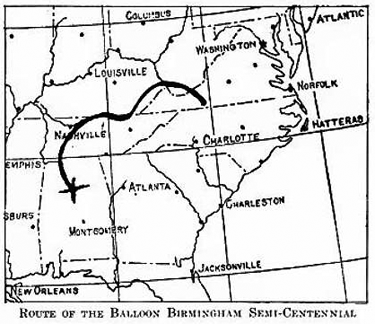Birmingham Semi-Centennial: Difference between revisions
(New page: :''This article is about the balloon. For the anniversary celebration, see Semicentennial of Birmingham.'' '''The Birmingham Semi-Centennial''' was a gas-filled manned balloon sponsore...) |
m (Typos) |
||
| (3 intermediate revisions by one other user not shown) | |||
| Line 1: | Line 1: | ||
{{About|the baloon|the anniversary celebration|Semicentennial of Birmingham}} | |||
''' | [[Image:1921 balloon race map.png|right]] | ||
The '''''Birmingham Semi-Centennial''''' was a gas-filled manned balloon sponsored by the [[City of Birmingham]] which competed in, and won, the [[1921 National Balloon Race]]. The race, organized by the [[Birmingham Aero Club]], was launched from Birmingham on [[May 21]], [[1921]] as part of the celebration of the city's [[Semicentennial of Birmingham|50th anniversary]]. | |||
The balloon was piloted by Ralph Upson, assisted by C. J. Andrus. | The balloon was piloted by veteran balloonist Ralph Upson of New York, New York. He was assisted by C. J. Andrus, Chief Director of the United States Weather Bureau. They won by traveling a total of 423 miles in 34 hours and 40 minutes before landing at a spot about 10 miles west of Stuart, Virginia. All of the other eight competitors landed in various parts of Tennessee, covering between 118 and 201 miles. | ||
By virtue of their victory, Upson and Andrus went on to compete in the 1921 International Spherical Balloon Race, launched from Brussels, Belgium on [[September 18]] in pursuit of the Gordon Bennett Cup. They brought ''The Birmingham Semi-Centennial'' with them, but the race officials disqualified the balloon. Instead, Upson borrowed a balloon from Ernest Demuyter, the Belgian champion of the [[1920 International Balloon Race]], which had taken place in Birmingham the previous year. Upson and Andrus finished in third place, setting down on the Lleyn Peninsula in North Wales. | |||
==References== | ==References== | ||
* {{Hornady-1921}} | * {{Hornady-1921}} | ||
* "Fourteen Balloons Leave Brussels in Race for Bennett Trophy, May Go Over Atlantic." (September 19, 1921) ''The New York Times'' | |||
* Andrus, C. J. (February 1922) "The 1921 International Spherical Balloon Race". ''Bulletin of the American Meteorological Society''. Vol. 3, No. 2, pp. 28-9 | |||
[[Category:Ballooning]] | |||
[[Category:1921 works]] | |||
Latest revision as of 11:55, 20 January 2014
- This article is about the baloon. For the anniversary celebration, see Semicentennial of Birmingham.
The Birmingham Semi-Centennial was a gas-filled manned balloon sponsored by the City of Birmingham which competed in, and won, the 1921 National Balloon Race. The race, organized by the Birmingham Aero Club, was launched from Birmingham on May 21, 1921 as part of the celebration of the city's 50th anniversary.
The balloon was piloted by veteran balloonist Ralph Upson of New York, New York. He was assisted by C. J. Andrus, Chief Director of the United States Weather Bureau. They won by traveling a total of 423 miles in 34 hours and 40 minutes before landing at a spot about 10 miles west of Stuart, Virginia. All of the other eight competitors landed in various parts of Tennessee, covering between 118 and 201 miles.
By virtue of their victory, Upson and Andrus went on to compete in the 1921 International Spherical Balloon Race, launched from Brussels, Belgium on September 18 in pursuit of the Gordon Bennett Cup. They brought The Birmingham Semi-Centennial with them, but the race officials disqualified the balloon. Instead, Upson borrowed a balloon from Ernest Demuyter, the Belgian champion of the 1920 International Balloon Race, which had taken place in Birmingham the previous year. Upson and Andrus finished in third place, setting down on the Lleyn Peninsula in North Wales.
References
- Hornady, John R. (1921) The Book of Birmingham. New York: Dodd & Mead
- "Fourteen Balloons Leave Brussels in Race for Bennett Trophy, May Go Over Atlantic." (September 19, 1921) The New York Times
- Andrus, C. J. (February 1922) "The 1921 International Spherical Balloon Race". Bulletin of the American Meteorological Society. Vol. 3, No. 2, pp. 28-9
